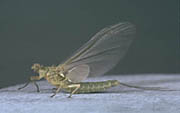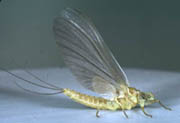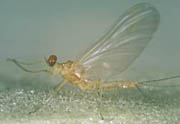
![]()
Trips
Montana
Missouri
SW
Montana
Clark Fork & Bitterroot
Bahamas
Andros Island
Upper Delaware
Other Destinations
Alaska
New Zealand
Argentina
Chile
![]()
News
![]()
River Updates
Hatch
Chart
![]()
Campground
![]()
Tips
Articles
ACFF
Photo Gallery
![]()
Al Caucci's Biography
Testimonials
![]()
Contact Us
Home
![]()
Your fishing logs at Ecolure
![]()
Friends of the
Upper
Delaware
![]()
1250 Winterdale Road
Starlight, PA, 18461
Phone : 1 ( 570 ) 635 - 5897
email : alcaucci@hancock.net

|
||||||
|
It's Sulphur Time Again! By Al Caucci
Except for the Hendrickson hatch in the East, the Hex hatch in the Midwest, and the Green Drake hatch in the West, I can't think of another hatch that causes more excitement among America's fly fishers than the sulphurs. Sulphurs have superior credentials: They're widespread from coast to coast; they arrive at the most pleasant time of year in terms of air temperature and river levels; their hatching and spinner activity lasts from four weeks to three months; their numbers are prolific; and they are extremely vulnerable. This Ephemerella super genus is responsible for all the "sulphur" activity throughout the country-invaria and dorothea in the East and Midwest, and infrequens and inermis in the West. East and Midwest The eastern and midwestern species of invaria are the first sulphurs to appear. They are the largest of the group (9 to 10mm/size 14 hook) vs. the dorothea (5 to 7mm/sizes 16 and 18 hook). The body color of invaria is more creamish vs. the light to deep yellow color of the smaller dorothea. Invaria prefer riffles and runs at the heads of pools, while the smaller dorothea are prevalent on quiet pools and flats. The larger invaria flies start hatching in mid May on Pennsylvania, New York and southern Appalachian waters, as well as in northern Michigan and Wisconsin, and they continue until early June. Activity starts a little later in New England and the Upper Peninsula of Michigan. The best action takes place on cloudy and rainy days. The smaller dorotheas are primarily a June evening hatch in the East and Midwest, although they will start in late May if the weather turns warm. Early on, the hatching and spinnerfalls may get the trout going as early as 7:00 P.M., but as the hatch continues, it starts progressively later until the heavy hatches and spinnerfalls occur at dusk or after dark. Proper size and pattern type (dun, emerger or spinner, as well as nymphs in the surface film) become critical to success as the trout feed steadily and selectively. On rivers with abundant hatches and spinnerfalls, selectivity will be the rule rather than the exception. On the Upper Delaware tailwater system, the dorothea activity starts at the end of May and continues well into August. The West The small, pale mayflies of Ephemerella infrequens and E. inermis are the western counterparts of the eastern sulphurs. These "pale morning duns" are the staples on the great western rivers like the Big Horn, Henry's Fork, Silver Creek and Deschutes. Like their eastern cousins, PMDs have the same hatching and body characteristics and occupy the same type habitat niche. The infrequens nymph is 8mm (size 16 hook), while inermis is 5 to 6mm (sizes 18 & 20). The duns resemble the eastern sulphurs, except their yellowish bodies have an olive cast, and the wings are pale gray with a hint of yellow. Western emergence dates are not conveniently predictable, due to differences in altitude, geo-thermal activity and subterranean springheads. For the most part, westerners can look for them after the runoff, when water temperatures reach approximately 55 degrees F. July is usually the best month for hatching. I use Comparaduns if the fish are feeding on the duns. Parachutes also work if tied in the proper size and color, although they are less durable. When the trout are on emergers, I like the Compara-emerger with trailing shuck and the CDC emerger. If they are sipping spinners, use flush floating spinner patterns in the correct size and color. Compara-spinners have hackled wings clipped top and bottom. Poly or Z-lon winged spinners are also very effective. Trout key on the sulphurs' most vulnerable aspects. Large fish usually wait until the hatch is well underway before beginning to feed, but they soon settle into a steady feeding pattern, selecting only the most vulnerable stages: emergers transitioning to duns, crippled duns riding the surface, and spinners lying motionless in the surface film. Although frustrating at times to many anglers, this is the way of wild and holdover trout. And what a wonderful challenge it is to solve the puzzle and hook a large, persnickety trout during the sulphur hatch!
|
||||||


